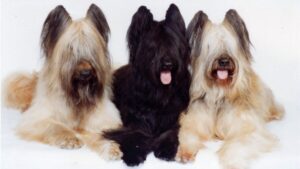
Living with the Briard
Living with the Briard: A loyal and affectionate breed needing clear leadership and socialization for a balanced urban lifestyle.
Home » Dog Breeds » Briard Dog Breed
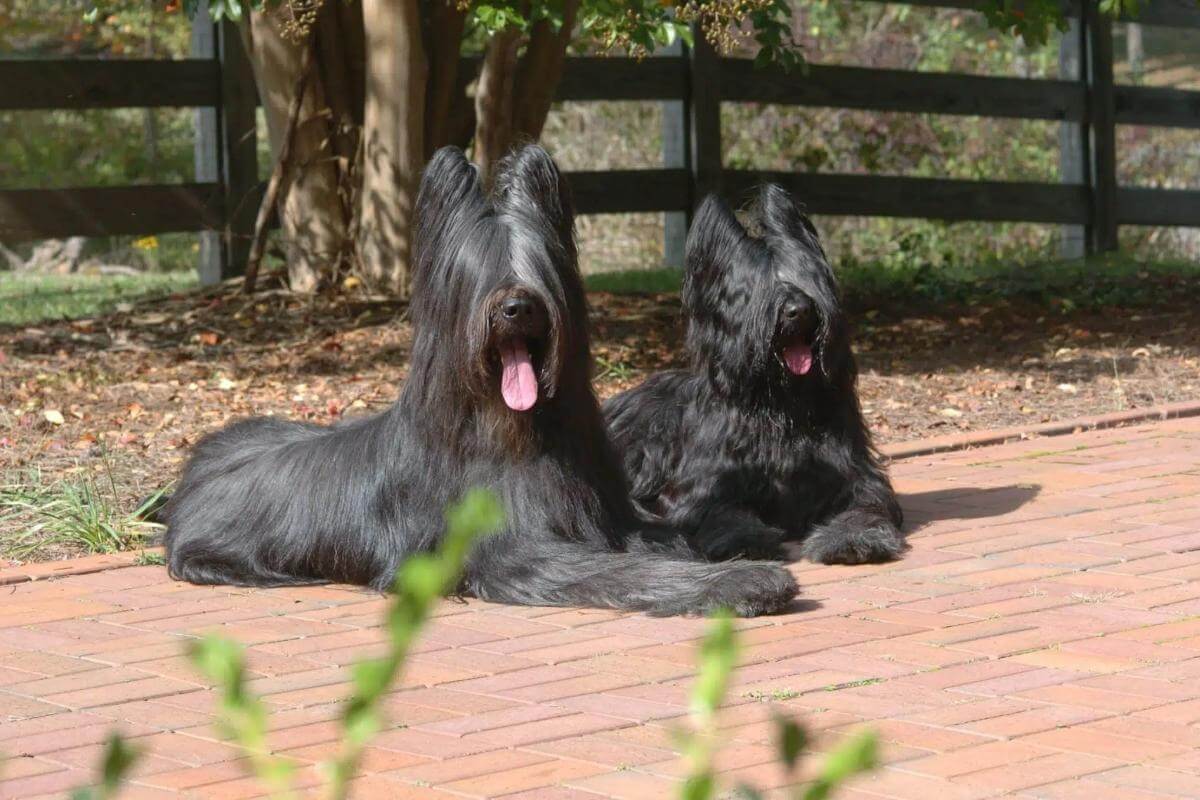
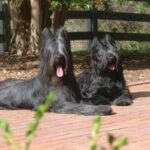
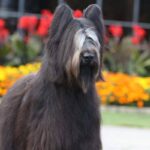


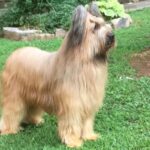
The Briard is a charming purebred known for its courage, loyalty, and high spirit. Hailing from France, this ancient shepherd’s dog has been a unique choice for people looking for a lively canine companion. The breed’s keen sense of duty and protective nature make it an excellent choice as a guardian, while its loving disposition makes it a cherished member of the family.
Herding
22 – 27 inches
55 – 100 pounds
12 years
| Country of Origin | France |
|---|---|
| Bred For | Herding, Guarding, Companionship |
| Known For | Coarse Coat, Intelligence, Confidence, Vigor |
| Popularity | Low |
| Temperament | Confident, Smart, Faithful |
| Activities | Herding, Guarding, Running, Conformation Shows, Dog Sports |
The Briard is a breed steeped in history, tracing its origin to the French countryside. Renowned for its impeccable herding and guarding abilities, the breed has been present in the country for centuries, serving as the shepherd’s loyal companion.
Many tales and lore surround the Briard, each contributing to the breed’s rich historical tapestry. There’s even mention of the breed in literature from the 8th century, underlining its longstanding presence in France. Emperor Charlemagne, as well as Napoleon, are believed to have had Briards.
Primarily used for guarding and herding sheep, the Briard’s keen senses, intelligence, and undying loyalty made it an invaluable asset. The dogs’ unique ability to herd and protect livestock from predators, particularly wolves, established them as a staple in French pastoral life.
The breed’s role underwent a transformation during the World Wars. Owing to its intelligence, determination, and acute sense of hearing, the Briard was employed by the military for various tasks, including detecting wounded soldiers and carrying supplies. This service further underscored the breed’s adaptability and valor.
It was only in the late 19th and early 20th centuries that the Briard began to be recognized as more than just a working dog. The breed gained prominence at dog shows, and the dogs’ distinctive characteristics began to attract the attention of enthusiasts outside France.
The American Kennel Club (AKC) officially recognized the Briard in 1928, cementing its status in North America as a breed of distinction. Additionally, other major canine organizations, including the FCI and The Royal Kennel Club (UK), extended recognition, propelling the breed to global notoriety.
While the Briard may not always be found working sheep in the French countryside today, its herding instincts remain strong. Modern-day Briards serve as companions, show dogs, and even Therapy Dogs, proving that their versatility and charm transcend time and purpose.
Adult male Briards typically stand between 23 and 27 inches tall at the shoulder, while mature females are slightly smaller, measuring around 22 to 25.5 inches.
Weight varies based on the overall size and build of the individual dog. Generally, adult Briards can weigh between 55 and 100 pounds.
The Briard presents a harmonious balance in its proportions. The body may be slightly longer than it is tall; however, the overall silhouette is square but not cobby. The breed is not merely a fluffy facade; beneath its luxurious coat lies a robust framework of strength and agility that showcases the Briard’s herding ancestry and its capacity for strenuous work.
Texture: The Briard boasts a harsh double coat that is both long and wavy. The outer coat is coarse and dry, ensuring it is resistant to the elements, while the undercoat remains soft and dense. The head is covered in long hair, parting naturally along the centerline of the face. The coat is hard and dry but has a good sheen. The hair lies flat, falling in slightly wavy locks, and has a texture that not only gives the Briard its distinctive appearance, it also provides a rasping sound when touched.
| Standard Color | |
|---|---|
| Black | ee |
| Tawny | ee |
| Gray | ee |
| Black & Gray | ee |
| Black & Tawny | ee |
| White | ee |
| Tawny & Gray | ee |
Markings: White Markings
A Note About Color: All uniform colors are acceptable, the deeper the shade the better. White is not an acceptable color; however, a small white spot on the chest and/or white hairs scattered throughout the coat are not uncommon in a good Briard.
The Briard’s tail is long and feathered, reaching at least to the hocks. It often has a distinctive “J”-shaped hook at the end, sometimes referred to as a “crook.” When the Briard is in motion or alert, the tail is lifted, showcasing its flowing and luxurious hair, but it doesn’t curl over the back. When relaxed, the tail hangs down.
The tail of the Briard is not docked, thus maintaining its natural length and shape. The long and expressive tail not only adds to the breed’s aesthetic appeal, it also provides balance and aids in communication, making it an essential aspect of the Briard’s anatomy and ability to express itself.
The Briard is more than just striking in appearance. Owning one of these distinctive dogs comes with the joy of sharing life with a loyal and spirited companion. However, potential Briard owners should be aware of certain breed-specific considerations.
The Briard is typically a robust and healthy dog, blessed with a sturdy constitution. However, like all breeds and mixed breeds, it can be susceptible to some health issues. Prospective owners should be aware of these and work closely with a trusted breeder and veterinarian to ensure the dog maintains optimal health throughout its life.
Lifespan: The lifespan of a Briard is typically around 12 years, but with proper care and exercise, regular check-ups, and a balanced diet, many can thrive beyond this average.
While the Briard is generally hardy, no dog is entirely exempt from potential health issues. Some of the risks associated with the Briard include:
It’s essential for Briard owners to be vigilant and proactive. Regular veterinary check-ups can help in early detection and management of these and other potential health concerns.
When considering bringing a Briard into the home, it’s essential to understand the breed’s personality traits. The Briard is an intelligent and spirited breed, known for its loyalty and keen protective instincts.
For novice owners, the Briard can be a bit of a challenge due to its strong-willed nature. However, with consistent training and early socialization, these dogs can become obedient and well-adjusted family members. Their sensitivity level is relatively high; Briards often form deep bonds with their families and can be quite intuitive about their owner’s feelings and needs.
Being alone is not the Briard’s favorite pastime. Given the herding background of these dogs, they prefer to be involved in family activities and can become distressed if left isolated for extended periods. This also ties into their relationship with other dogs. Briards can get along well with other dogs, especially if they’ve been introduced and socialized from a young age.
Their protective instincts extend to their relationship with young children. Briards are generally patient and gentle with kids, making them suitable companions for families. However, due to their herding instincts, they might attempt to “herd” young children, so supervision is recommended during interactions.
When it comes to strangers, the Briard’s initial reaction might be one of caution. These herding dogs are naturally protective and may take some time to warm up to unfamiliar faces. But with proper introductions and positive experiences, they can be quite sociable.
Providing the right nutrition is paramount for the overall well-being and longevity of a Briard. Being an active and sizable breed, the dietary needs of this herder can be different from other dogs.
For Briard puppies, it’s essential to provide a balanced diet that supports their growth phase. Puppies have unique nutritional needs, and it’s crucial to choose a high-quality puppy food that ensures they get all the necessary vitamins and minerals for strong bone and muscle development. Typically, Briard puppies should be fed more frequently, about 3-4 times a day, transitioning to two times as they approach adulthood.
An adult Briard, depending on its weight and activity level, might require about 2.5 to 3 cups of high-quality dog food daily, split into two meals. It’s essential to note that the exact amount can vary based on individual metabolism, age, and exercise intensity. Overfeeding can lead to obesity, a growing concern among many dog owners. Hence, it’s advisable to monitor the Briard’s weight and adjust food portions accordingly.
When considering the type of food for a Briard, whether commercial or home-cooked, it’s important to be sure it is high in protein and contains balanced fats. Given the breed’s lush coat, foods rich in Omega-3 and Omega-6 fatty acids can help to maintain its sheen and strength.
Always ensure fresh water is available for your Briard. And while treats can be a good training aid, remember to give them in moderation to prevent weight gain and potential nutritional imbalances.
Lastly, consulting with a veterinarian or a pet nutritionist can provide tailored advice, ensuring that the Briard’s dietary needs are adequately met throughout its life stages.
Training a Briard is a journey of understanding and cooperation. These dogs, with their sharp intelligence and eagerness to learn, can quickly grasp commands and tricks. This intelligence, however, has a flip side; they can easily get bored if not mentally stimulated. So, in addition to physical activities, it’s essential to engage them with puzzles and interactive toys to channel their intellectual energy positively.
Briards possess an independent nature owing to their herding background, which means they might occasionally test boundaries. It’s crucial to establish a bond of trust and leadership early on in their training. Positive reinforcement techniques work best with this breed, as the dog’s sensitive nature might not respond well to harsh methods.
A noteworthy trait of the Briard is its moderate tendency to bark. While these dogs aren’t excessive barkers by nature, they will vocalize if they sense something amiss in their surroundings. Through consistent training, they can be taught commands like “quiet” or “enough” to control their vocalizations.
The Briard’s herding lineage also brings with it certain behaviors, such as a potential to roam or chase. For instance, if a Briard senses something interesting beyond its usual territory, the dog might be inclined to investigate. A robust recall command and ensuring the immediate environment is secure can help to manage this wandering nature. Similarly, the breed’s instinct to chase, especially smaller animals or moving objects, can be redirected through training and early socialization.
Exercise plays a pivotal role in the life of a Briard. Originating as a herding dog, the breed is endowed with a significant amount of energy and stamina, requiring regular physical activity to keep these dogs happy and healthy. Without adequate exercise, this vibrant breed might resort to undesirable behaviors, often stemming from boredom or pent-up energy.
| Energy Level | Moderate to High |
|---|---|
| Exercise Requirements | 2 Hours/Day (Minimum), Daily Walks, Vigorous Running, Regular Exercise, Playing with Another Dog, Mental Stimulation |
The Briard’s exercise needs are relatively high, reflecting their working background. A simple walk around the block might not suffice for these energetic dogs. They thrive on activities that engage both their minds and bodies. Hence, long walks, hikes, play sessions, and even Agility or Herding Trials can be beneficial and enjoyable for them.
In terms of energy level, the Briard is notably spirited. These dopgs possess an inherent drive to work and play, making them ideal companions for active families or individuals. Their enthusiasm, paired with their intelligence, also means they excel in dog sports and training sessions where they can channel their energy productively.
The Briard’s playfulness is evident in its interactions, be it with other dogs or with its human family members. These dogs love engaging in games of fetch, tug-of-war, or even interactive toys. However, it’s essential to ensure that play sessions are controlled, especially if there are smaller animals or young children around, due to the Briard’s herding instincts.
Intensity is another hallmark of the Briard’s exercise regimen. While these dogs are always up for rigorous activities, it’s crucial to monitor them, especially in extreme weather conditions, ensuring they don’t overexert themselves.
Grooming a Briard is an integral aspect of the dog’s care, especially given its luxurious, long double coat. This breed’s coat is not only a sight to behold but also a testament to its historical work in diverse terrains, providing adequate protection against harsh weather conditions.
| Coat Type | Hard and Dry, Long, Slightly Waving, Rasping |
|---|---|
| Grooming Requirements | Daily Brushing, Occasional Bathing, Routine Ear Cleaning, Periodic Nail Trimming, Regular Tooth Brushing |
The Briard’s coat, while beautiful, requires consistent maintenance to ensure it remains tangle-free and healthy. Regular brushing, at least a few times a week, is essential to prevent mats and knots from forming, particularly in areas prone to tangles such as behind the ears, under the legs, and around the collar area. These sessions can also serve as a bonding time between the dog and the owner, making it a pleasurable experience for both.
Shedding is a natural process, and while Briards are not heavy shedders, they do lose hair, especially during seasonal changes. Regular grooming can help with managing and reducing the amount of hair around the house.
While the coat is a primary focus in grooming, other aspects of Briard care should not be overlooked. The ears should be checked and cleaned regularly to prevent infections, and the nails should be trimmed to avoid overgrowth that can cause discomfort or lead to injuries. Dental hygiene is also paramount; brushing the Briard’s teeth or providing dental chews can help with keeping oral issues at bay.
Briards are known for their “griffon-like” beard, which can sometimes get messy, especially after meals. A quick wipe or occasional wash can help to keep this area of the coat clean.
Bathing a Briard doesn’t need to be a frequent affair; doing so when they get particularly dirty or start to have an odor is usually sufficient. However, post-bath, it’s vital to dry the coat thoroughly to prevent any moisture-related skin issues.
Living with a Briard is a rewarding experience that comes with its own set of considerations due to the breed’s distinctive traits. As a herding breed with a rich history, the Briard brings a mix of energy, intelligence, and affection into a household.
For urban dwellers considering a Briard, it’s crucial to understand that while these dogs can adapt to apartment living, they require ample space every day to move and play. The dog’s size and energy level make a spacious environment more conducive to its well-being. If living in a confined space, it becomes even more critical to ensure the Briard gets its daily dose of exercise and mental stimulation.
Climate can play a role in the comfort of a Briard. With its thick double coat, these dogs are naturally well-equipped for colder weather. They can frolic in the snow and handle lower temperatures quite well. However, the same coat can make them more sensitive to extreme heat. During hotter months, it’s important to provide them with a cool, shaded environment and avoid intense physical activity during peak hours of sunshine.
While Briards are loyal and protective, making them excellent watchdogs, their herding instincts might sometimes manifest in the home environment. They could attempt to “herd” family members, especially young children, by nipping at their heels or circling around them. It’s essential to train them early on to manage these instincts and to always ensure safe interactions.
Socialization is paramount for a Briard. Introducing this breed to various environments, people, and other animals from a young age can help in molding a well-rounded and confident adult dog. The breed’s protective nature means these dogs can be wary of strangers, so positive experiences with various individuals can help with curbing any undue apprehension.
The introduction of a Briard puppy into a household is a moment filled with excitement and anticipation. These little bundles of energy bring immense joy and, with their curious eyes and playful antics, can quickly become the center of attention. However, caring for a Briard puppy, as with any young dog, demands dedication, understanding, and a commitment to their well-being.
From the moment a Briard puppy steps into its new home, it’s vital to create an environment conducive to its growth and development. Establishing a routine early on helps the puppy adjust and understand what’s expected. This includes regular feeding times, potty breaks, and play sessions.
Nutrition plays a pivotal role during this growth phase. A balanced diet, specially formulated for puppies, provides them with the essential nutrients required for their development. Consulting with a veterinarian can help to guide the right dietary choices and quantities, ensuring the puppy thrives and builds a strong foundation for adulthood.
Socialization, as with adult Briards, is paramount during the puppy phase. Exposing puppies to various sounds, sights, people, and other animals helps in building confidence and reduces the chances of them becoming overly cautious or aggressive in unfamiliar situations.
Training should begin early, capitalizing on the breed’s keen intelligence and eagerness to learn. Simple commands, housebreaking, and leash training are some of the basics to start with. Given their herding instincts, early training can also help to curb behaviors like nipping or excessive chasing.
Physical health is crucial, of course, but so is mental well-being. Briard puppies are curious and eager to explore, so providing them with toys, puzzles, and interactive games can help to stimulate their minds. Puppies that are actively engaged are less likely to develop undesirable behaviors out of boredom.
Lastly, while Briard puppies are naturally playful and energetic, it’s essential to be certain they don’t overexert themselves. Their bones and joints are still developing, and excessive or rough play can lead to injuries.
The Briard’s rich heritage as a working and herding breed means that they’re not just content lounging around. They have a deep-seated need for activity, both mentally and physically. As such, these dogs thrive in environments where they can channel their energy and intelligence into constructive outlets.
The Briard is a versatile breed, making it suitable for a wide range of activities. Engaging the Briard in these activities not only showcases its many talents, it also provides the mental stimulation and physical exercise that this breed craves.
The Briard is recognized by the world’s leading registries and kennel organizations, which categorize the breed into a specific Group based on its unique characteristics. This breed is recognized worldwide under the following Group designations:
| Organization | Group Designation |
|---|---|
| AKC (American Kennel Club) | Herding |
| UKC (United Kennel Club) | Herding Dog |
| CKC (Canadian Kennel Club) | Herding |
| ANKC (Australian National Kennel Council) | Working |
| RKC (The Royal Kennel Club) | Pastoral |
| FCI (Fédération Cynologique Internationale) | Group 1: Sheepdogs and Cattledogs Section 1: Sheepdogs |
The ideal Briard is described by a Breed Standard that is approved by each of the world’s leading registries and kennel organizations. The Breed Standards for this breed may be found in the following links:
| Organization | Breed Standard |
|---|---|
| American Kennel Club | AKC Briard Breed Standard |
| United Kennel Club | UKC Briard Breed Standard |
| Canadian Kennel Club | CKC Briard Breed Standard |
| Australian National Kennel Council | ANKC Briard Breed Standard |
| The Royal Kennel Club | RKC Briard Breed Standard |
| Fédération Cynologique Internationale | FCI Briard Breed Standard |
Several dedicated organizations across the globe champion the Briard, offering invaluable resources, expertise, and community connections for those interested in learning more about the breed.
In the United States, the primary organization dedicated to the breed is the Briard Club of America (BCA). Established in 1928, the BCA has been a steadfast advocate for the Briard, working closely with the American Kennel Club. The club’s members are deeply involved in organizing events, producing educational resources and orchestrating rescue efforts for the breed.
In Canada, the Canadian Briard Club stands as a beacon for Briard enthusiasts. Collaborating with the Canadian Kennel Club, the CBC has made significant strides in promoting, protecting, and bettering the Briard, ensuring it continues to thrive in Canadian households and on Canadian farms.
In the United Kingdom, the Briard Association takes the helm in representing the breed. This esteemed organization holds a close association with The Royal Kennel Club and is integral in hosting breed-specific events, educational initiatives, and upholding the highest standards for the preservation of the Briard.
For those passionate about the Briard, getting involved with these organizations can prove immensely beneficial. They not only provide a gateway to understanding the breed deeper but also open doors to a community that shares an unwavering love for the Briard.
The commitment to ensuring every Briard has a loving home extends beyond breeders and enthusiasts. Rescue groups play a pivotal role in this endeavor, offering Briards that may have faced hardships or abandonment a second chance at a fulfilling life.
In the United States, there’s a concerted effort by organizations such as the Briard Rescue and Haven to rehabilitate and rehome Briards. They take in Briards in need, provide them with necessary medical care, training, and most importantly, love until they find their forever homes.
For those considering bringing a Briard into their lives, adopting from a rescue group can be a heartwarming option. Not only does it give a Briard another chance at happiness, but it also opens up a space for another dog in need. While breed-specific rescue groups are a wonderful resource, it’s also worth noting that many dog rescue organizations and local shelters could also have a Briard looking for a home.
While no dog breed is truly hypoallergenic, Briards are often considered to be among the breeds that are less likely to trigger a person’s allergies. Their wavy coats can help to trap dander, preventing it from becoming airborne. However, to ensure there’s no reaction, individuals with severe allergies should spend time with a Briard before deciding to bring one home.
Briards shed, but their unique coat texture means that the hair often gets trapped within the surrounding hairs. As a result, they don’t typically shed all over the house like some breeds do. Regular grooming is essential to remove this trapped hair and to prevent matting.
Absolutely! Briards are known for their loyalty and deep attachment to their families. They are particularly gentle and protective of children, making them excellent family companions. Their herding instinct, however, might lead them to “herd” younger members of the family, so supervision is essential during interactions.
Briards make wonderful pets for those who understand and appreciate their unique characteristics. They are loyal, intelligent, and can be quite playful. However, they also require consistent training, socialization, and grooming to ensure they are well-behaved and comfortable in various situations.
Briards are not inherently aggressive. However, they do possess a strong protective instinct, which means they can be wary of strangers or when they find themselves in unfamiliar situations. Early socialization and consistent training are crucial to ensure that their protective nature doesn’t lead to unwanted aggressive behaviors.
Yes, Briards are highly intelligent dogs. Their herding background means they are quick thinkers, adept problem solvers, and very trainable. Their intelligence, paired with their desire to please their owners, makes them responsive to training, though they can have a stubborn streak at times.
The average lifespan of a Briard is around 12 years. With proper care, regular check-ups, and a balanced diet, many Briards can thrive and even surpass this age. As with all dogs, it’s important to be sure they lead a healthy lifestyle as this can significantly influence their longevity.
The Briard’s coat, much like human hair, continues to grow throughout its lifetime. This means regular grooming is essential to keep the coat at a manageable length and to prevent tangling and matting. Without proper grooming, the Briard’s magnificent coat can become overly long and difficult to manage.

Living with the Briard: A loyal and affectionate breed needing clear leadership and socialization for a balanced urban lifestyle.
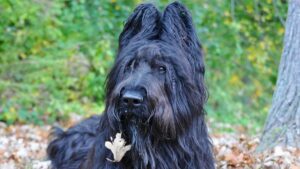
Briard Temperament: Discover the complex charm of the Briard breed—intensely affectionate yet discerning, with unique socialization needs.
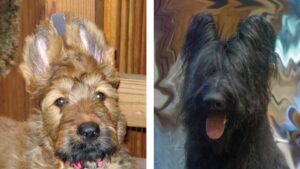
Learn how to judge the Briard, focusing on key features, movement, and grooming standards to appreciate this elegant and intelligent breed.

Insights from Odile Smith, Breeder of Fairytale Briards, on breed type, health, and the dog show community.
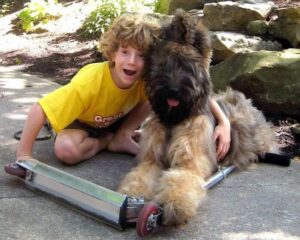
Unlock your dog’s full potential with socialization! Build confidence, friendliness, & sociability for a happier, well-adjusted pet.
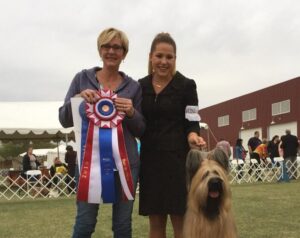
Interview with Herding Group Breeders Gina & KayCee Klang – I live in Thousand Palms, California, about two hours east of Los Angeles and 10
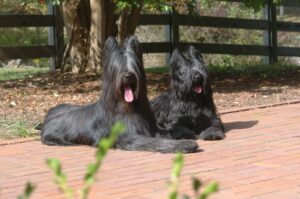
Owner Handler’s Sharon Onorato Utych & James Utych: We became involved in the sport when we got our first Cavalier King Charles Spaniel.
The Briard is handsome, alert and powerful without coarseness. He must possess the structural integrity and mental versatility necessary to

Living with the Briard: A loyal and affectionate breed needing clear leadership and socialization for a balanced urban lifestyle.

Briard Temperament: Discover the complex charm of the Briard breed—intensely affectionate yet discerning, with unique socialization needs.

Learn how to judge the Briard, focusing on key features, movement, and grooming standards to appreciate this elegant and intelligent breed.

Insights from Odile Smith, Breeder of Fairytale Briards, on breed type, health, and the dog show community.

Unlock your dog’s full potential with socialization! Build confidence, friendliness, & sociability for a happier, well-adjusted pet.

Interview with Herding Group Breeders Gina & KayCee Klang – I live in Thousand Palms, California, about two hours east of Los Angeles and 10

Owner Handler’s Sharon Onorato Utych & James Utych: We became involved in the sport when we got our first Cavalier King Charles Spaniel.
The Briard is handsome, alert and powerful without coarseness. He must possess the structural integrity and mental versatility necessary to
The best way to ensure a long and happy relationship with a purebred dog is to purchase one from a responsible breeder. Not sure where to begin?
Contact the National Parent Club’s Breeder Referral Program, which is listed on the AKC Breeder Referral Contacts page.


"*" indicates required fields
Showsight Magazine–the world’s most influential purebred dog publication since 1992. Each issue reaches a global audience dedicated to preserving the history and health of purpose bred dogs. Filled with award-winning editorial focused on news and insights from the dog show community, top breeders, handlers, AKC Judges, and more!